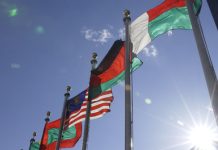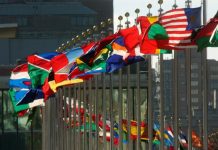Photo credit: DiasporaEngager (www.DiasporaEngager.com).
Littane Ilfrard traces the deep and complex history of immigration to highlight why today’s Haitian immigrants in the U.S. deserve better.
By Littane Ilfrard, Haitian Times —
The immigrant story is one that’s been told over and over again and continues to be recounted. It’s a story that doesn’t end. One with multiple layers. One that’s been revised over and over again. It dates back to as far as time can tell, before there were official borders and immigration laws dictating who belongs and who doesn’t, who’s a citizen and who isn’t, who can stay and who can’t.
It predates everyone reading this, Americans and non-Americans alike. Immigration predates Castle Garden and the Barge Office, the immigration stations in the Battery of Manhattan that were used to process eight million European immigrants between 1855-1890. The mass influx of immigrants was so great that it led to the construction of Ellis Island, through which more than 12 million immigrants – most of them Europeans and the parents, grandparents, and great-grandparents of many of today’s Americans – were processed between 1892-1954 prior to resettling throughout this country.
Immigration to what is now the United States – both forced and voluntary – predates the American Revolutionary War, the War of 1812, and the American Civil War. It predates the U.S. Constitution. It predates the 1779 Battle of Savannah, one of the deadliest battles in the American Revolution, in which an estimated 500 Haitian soldiers fought alongside American and French soldiers against the British as infantry volunteers of Chasseurs-Volontaires de Saint-Domingue.
It predates Jean Baptiste Point du Sable’s (a Haitian man) arrival to Chicago in the 1770s as the first permanent non-indigenous resident, earning him recognition as Chicago’s founder. It predates every major U.S. immigration law, including the 1790 Naturalization Act, the Immigration Act of 1882, the 1917 Immigration Act, and the 1965 Immigration and Nationality Act.
It predates 1804, the year Haiti gained its hard-fought independence and declared itself free after 13 years of fighting and defeating Napoleon Bonaparte and his French army, the Spanish, and the British. It predates the Louisiana Purchase in 1803 – a direct result of the Haitian Revolution and Haitians gaining their liberty – and the immigration of French colonists and their slaves to present-day Louisiana from Saint-Domingue. It predates Simon Bolivar and his war for independence in South America, with assistance from Haiti, and the independence of Venezuela, Colombia, Panama, Ecuador, Peru, and Bolivia.
It predates 1885, the year a certain former U.S. president’s grandfather, a German immigrant himself, came to America – one of an estimated one million German immigrants who settled in this country that year.
Immigration to the U.S. predates American scholars and intellectuals like W.E.B. Du Bois, the son of a Haitian man and the first African American to earn a PhD from Harvard University. It predates his founding, along with others, of the NAACP in 1909 in the aftermath of the deadly race riots of 1908 in Springfield, IL. It predates the 1904 and 1906 race riots of Springfield, OH.
Immigration to the U.S. predates American scholars and intellectuals like W.E.B. Du Bois, the son of a Haitian man and the first African American to earn a PhD from Harvard University. It predates his founding, along with others, of the NAACP in 1909 in the aftermath of the deadly race riots of 1908 in Springfield, IL. It predates the 1904 and 1906 race riots of Springfield, OH.
It predates November 29, 1947, when Haiti cast one of the last three votes in favor of UN General Assembly Resolution 181, also known as the Partition Resolution, approving the division of Great Britain’s former Palestinian mandate into two states, giving Israel official membership in the international community for the first time.
It predates the 1960s, when Haitians began arriving to North American cities like New York, Boston, Miami, Chicago, and Montreal to escape persecution by the Duvalier regime. Immigration predates 1960, when hundreds of Haitian doctors, engineers, professors, and teachers, invited by UNESCO and the Congolese government, participated in the United Nations Organization in the Congo (UNOC) mission to help establish infrastructure in the Democratic Republic of the Congo post-independence. It predates many other Haitian professionals’ participation in UN-sponsored programs in other newly independent African countries such as the Republic of Congo (Brazzaville), Cameroon, and Benin – an estimated 7,500 in total.
Immigration predates the January 2010 earthquake in Haiti that killed an estimated 300,000 Haitians, displaced hundreds of thousands more, and led tens of thousands to eventually migrate to Brazil, Chile, and other South American countries.
It predates the Cuban Revolution of 1959 and the rise of Fidel Castro. It predates 1994 and 1995, the years Cuban and U.S. officials signed migration agreements that led to the Clinton administration’s implementation of its 1995 “Wet-Foot Dry-Foot” policy. This resulted in the U.S. Government issuing travel documents to at least 20,000 Cuban migrants a year and allowing Cuban nationals who reached U.S. soil to resettle in the U.S., fast-tracking them for U.S. citizenship while their Haitian counterparts who also reached land continued to be turned away.
It predates every U.S. president and politician who has ever been in office and served this country.
The story of immigration to the U.S. is nothing new whether it’s by Ukrainians, Somalis, Vietnamese, Iranians, Nigerians, Jamaicans, Mexicans, Brazilians, Afghans, Venezuelans, Indians, Cubans, Nicaraguans or by the Irish, Scottish, British, Poles, Spanish, French, Portuguese, Germans, or Italians. The story of immigration to the U.S. is one that has been made possible by and at the expense of this country’s true and original inhabitants; its original Americans – Native Americans.
Immigration and immigrants are at the very core of the American story. They are the American story. Immigration is woven into the very fabric of this country. It’s who we are and what we are. It’s what makes us Americans. It’s what has made this country and continues to make and sustain this country. Without immigration, this country wouldn’t be what it is today. It wouldn’t be the most powerful nation in the world. It wouldn’t be a country known for progress, advancement, innovation, and freedom.
Immigrants have been and will continue to be the heartbeat and engine of this country, taking the jobs that no one else wants, working long hours, doing gig work, and earning hourly wages that many of us can’t imagine subjecting ourselves to, all in the spirit of pursuing what we all want – the American Dream or some version of it.
What is happening in Springfield, Ohio is characteristic of most retellings of the U.S. immigration story
Recent attacks on Haitian immigrants in Springfield, Ohio remind us of how divisive of an issue immigration is despite its benefits to our economy, our workforce, and our communities. Illegal immigration to the U.S. has been a contentious issue in both election and non-election years. But that’s not the issue at hand as Haitian immigrants in Springfield are documented as legal permanent residents, holders of temporary protective status, beneficiaries of humanitarian parole, and more.
The attacks, threats, hatred, and vitriol directed at the Haitian immigrant population of Springfield is also a reminder of how the national debate on immigration has been manipulated for political gain and used to ‘other’ and marginalize certain groups. It shows how the narrative has been twisted to sow fear and incite violence against them.
It’s a reminder that words have power and when they’re used by former presidents, elected officials, politicians, campaign staffers – people in positions of power who know better and some of whom have taken an oath to serve, protect, and uphold truth and justice – to stoke fears, to denigrate, to dehumanize, and to destroy a group of people for the sake of votes and to strengthen their political base, they’re no longer just words, just lies, or just rumors. It becomes sanctioned hate speech. It’s racism and prejudice in their purest forms masked as a ‘clash of cultures’ and as a ‘strain on resources.’ This unwanted attention and scapegoating is dangerous for Haitians, Haitian Americans, and their communities, and has subjected them to discrimination, verbal abuse, physical violence, vandalism, bomb threats, and other forms of hostility and aggression.
Just as immigration to the U.S. is nothing new, racism against immigrants, especially non-white immigrants, is also nothing new. Time and time again, Haitian immigrants in the U.S. have been the target of racism and negative stereotyping whether in New York, Boston, Miami, or other cities through public policies such as the “Wet-Foot Dry-Foot” policy and the Center for Disease Control and Prevention’s (CDC) unjustified inclusion of Haitians, the only ethnic group, on its list of groups of people considered to have the highest risk of contracting HIV/AIDS in 1982. (In April 1985, the CDC removed Haitians from their list because “scientists [could] no longer justify including them on statistical grounds.”)
For a country that’s made up almost entirely of immigrants, both old and new, from every part of this world (with Native Americans being the only exception); a country that was built by immigrants; a country that’s powered by immigrants; a country that runs on the backs of immigrants; and a country that was established by the free, forced labor of enslaved Africans forced to migrate, it’s shameful and it’s disgraceful.
As onlookers, as citizens and non-citizens, as members of other immigrant groups, and as voters, we can’t stand by idly and watch. We have to use our privilege, our voices, and tools at our disposal to ensure this is the last time any immigrant group comes under attack like this in a country made for and by immigrants.
For those interested in supporting the Haitian community in Springfield, Ohio, below is a list of organizations to consider supporting:
Haitian Community Help & Support Center
Guides and assists refugees and immigrants, especially Haitian nationals residing in Clark County and the surrounding area.
Address: 1530 S Yellow Springs St Springfield, OH 45506
Phone: (937) 408-6194
Email: haitiansupportcentersprinfield@gmail.com
Website:https://www.haitiansupportcenterspringfield.org/
United Way of Central Ohio – The Springfield Unity Fund
Provides targeted services to Springfield nonprofits supporting Haitian neighbors.
Address: 215 N. Front St., Suite 600, Columbus, OH 43215
Phone: (614) 227-2700
Website: https://givebutter.com/SpringfieldUnityFund
Haitian-American Community Association of Central Ohio
Address: 3510 Sullivant Avenue, Columbus, OH 43204
Phone: (614) 486-6300
Website: https://www.hacaco.org
Columbus Urban League
Address: 788 Mt. Vernon Avenue, Columbus, OH 43203
Phone: (614) 257-6300
Website: https://www.cul.org
Littane Ilfrard is a former U.S. diplomat with the State Department who completed tours in Ethiopia, Brazil, and Washington, D.C. and short tours of duty in Haiti and Cape Verde. Her work focused on economic and political issues and consular affairs. She is the proud daughter of Haitian immigrants and is originally from Cambridge, MA.
Source: Haitian Times
Featured image: Welcome to Springfield, Ohio, mural. Photo by David Wilson, Sept. 9, 2021, via Wikimedia Commons
Source of original article: The Institute of the Black World 21st Century (ibw21.org).
The content of this article does not necessarily reflect the views or opinion of Global Diaspora News (www.GlobalDiasporaNews.com).
To submit your press release: (https://www.GlobalDiasporaNews.com/pr).
To advertise on Global Diaspora News: (www.GlobalDiasporaNews.com/ads).
Sign up to Global Diaspora News newsletter (https://www.GlobalDiasporaNews.com/newsletter/) to start receiving updates and opportunities directly in your email inbox for free.





























